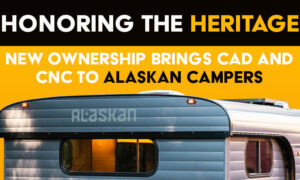TCM visits the Alaskan Camper factory in Chehalis, Washington to see the fifty-third year of Alaskan Campers built from the ground up. Look out, there’s a Mini!

We recently had the opportunity to visit Bob Livingston, Publisher of Trailer Life and Motorhome Magazines, when we visited the headquarters for Affinity Group in Ventura, California. It would be a gross understatement to say that Bob is a fellow truck camper enthusiast, but that’s literally another story. During our visit, Bob showed us the Affinity Group collection of Camper Coachman magazines from the late 1960s and early 1970s and we had a wonderful time leafing through them.
The only truck camper manufacturer in those forty year old magazines that’s still in business today is Alaskan Campers. Even more amazing, the Alaskan Campers from that era look nearly identical to the Alaskan Campers of today. Alaskan’s owners and manufacturing facilities have changed since the company’s debut in 1957, but most of how Alaskan Campers are designed and built has not.
So imagine our surprise when we walked through the Alaskan factory doors and saw a giant thirteen-foot Alaskan Camper flat bed model destined for a Unimog. And there was an Alaskan Mini, the “new” Alaskan Camper model that debuted in March of 2009. Clearly Alaskan Campers is an old company that’s learning a few new tricks.
 |  |  |
LEFT: The Alaskan Camper factory location would be perfect for a superhero’s hideout. Located on top of a steep hill, the factory is completely surrounded by a curiously dense wall of trees, bushes, and other shrubbery. So is Bryan Wheat, Alaskan Camper’s President, really a superhero? Alaskan Man, your secret is safe with us.
CENTER: The Alaskan Camper team is much the same as we left them on our 2007 tour. And they’re still sporting those sporty looking blue overalls. Left to right the team is Rick Bremgartner, Bryan Wheat, John Crabworth, Dorrie Benson, Dave Schmidt, Dalton Giesy, and Matt Chesler.
RIGHT: This photograph shows about half of one side of the Alaskan Factory. On the left you can see where Alaskan Camper bottoms are manufactured. On the right is where Alaskan Camper tops and bottoms are married and go through final finishing. On the other side you would see where Alaskan builds their pop-up camper tops.
 |  |  |
Alaskan Campers are built in sections by a a six-member production team that focuses on five categories; cabinetry, camper bottoms, camper tops, camper assembly, and final finishing. The sixth team member is Rick Bremgartner, Alaskan’s Foreman, who helps the team anywhere he’s needed and keeps a close eye on quality control.
Dalton Giesy is Alaskan’s cabinet maker. He’s responsible for building the overhead cabinets, the kitchen cabinets, counter tops, and storage cabinets. In these three photographs you see Dalton building the passenger side cabinetry for a custom ordered Alaskan Camper.
 |  |  |
LEFT: When we last saw him, Dave Schmidt was Alaskan’s cabinet maker. Since then, the bottom builder joined the Army and Dave is now building the Alaskan Camper bottoms. In this photograph you can see two Alaskan Camper bottoms upside down. The camper on the right has been painted with a layer of water resistant black sealant.
CENTER: Alaskan offers an insulated floor option that adds a layer of closed foam insulation under what would otherwise be the camper floor. Here Dave has completed placing the foam which he will then cover with a layer of plywood and then paint with the water resistant black sealant.
RIGHT: When the bottom structure is completed and the sealant has dried, two Alaskan team members flip the floor right side up and move it to the next station. There the camper will be skinned and the wiring, plumbing, gas lines, hydraulic lines, appliances, and cabinetry will be installed.
 |  |  |
Opposite from where Dave builds the camper bottoms, John Crabworth builds the camper tops. John is quite the character and one never knows if he’s kidding or serious. In fact the only thing that was clear about John was that he knew exactly how to build an Alaskan camper top.
LEFT: Here John is using a jig guide to literally walk a pencil line across an Alaskan roof panel. If you look closely, you can see additional notches on the jig guide that John uses to pencil other cut lines onto the roof panels. Some of Alaskan’s building techniques may be old school, but they work.
CENTER: Pencils down, John picked up a router and cut a window out of the framed and paneled sidewall. This is the side window on both sides of an Alaskan Camper top.
Alaskan Camper tops are framed with two-inch by two-inch microlam beams, an engineered timber that laminates thin wood layers with alternating grain structures. Using microlam beams dramatically increases the strength of modern Alaskan Camper tops without adding additional material.
RIGHT: With the cabover top installed, John uses an industrial staple gun to further secure the overcab to the main part of the camper top. With this step completed, John will install the wiring, spray in urethane foam insulation, cut and shape the insulation, skin the top with aluminum, and install the exterior lights. Each top takes John up to a week to be completed.
 |  |  |
Once Dalton has completed a set of cabinets, Dave has completed a camper bottom, and John has completed a camper top, it’s time for Matt Chesler to put everything together and form a new Alaskan Camper.
Assembling a camper top and bottom is a very intricate and critical step in the manufacturing of an Alaskan Camper. The top and bottom must be completely square and lined up carefully or the Alaskan hydraulic pop-up lift mechanism will bind. After building Alaskan Campers for over half a century, Alaskan has this tricky step down.
Joining the two sections begins by raising the top with two mechanical jacks. The camper bottom is then wheeled under the camper top. The alignment between the two halves is measured and remeasured several times before lowering the top onto the bottom. After all the time and effort Dave and John put into the top and bottom sections, there’s no room for mistakes.
With the top and bottom together, Matt gets to work connecting the hydraulic lift system. Once the hydraulic lift system is connected and the top is lifted, Matt installs the raise and lower guides to finish the camper top and bottom marriage.
During our visit to Alaskan, Matt was spending his time working on the custom flatbed Unimog Alaskan. In these three photographs Matt is installing the rear door (left) and cutting and installing the interior weather stripping (center and right).
 |  |  |
Most of the campers manufactured at Alaskan are either the ten-foot or eight-foot models, but every once in a while the team tackles a special project. The two days we were at Alaskan they were completing such a special project in the form of a thirteen-foot flatbed Alaskan destined for a Unimog. That’s right, a Unimog.
You may recall a similar Alaskan Unimog rig in our article titled, “Unimog Meets Alaskan”. It seems there something going on with Alaskan Campers and Unimogs. There’s no doubt that the two make for an interesting pair.
LEFT: In the top row of photographs you see the Alaskan Unimog camper’s exterior. This photograph shows the large Alaskan in its closed position. We shot this picture as Matt was testing the camper’s hydraulic lift system.
CENTER: Here the Unimog Alaskan’s top has been lifted and the under the overcab storage area has been opened. It was impressive to see how much storage this camper will have just by extending the overcab down.
RIGHT: This is a close-up of the under the cabover storage area. There are doors on both sides of the overcab storage area making it a pass-through. You can also see the 100 gallon fresh water tank located on the front wall of the camper. That’s a lot of water for a camper with only a five gallon cassette toilet.
 |  |  |
LEFT: When these photographs were taken, Matt was still completing the inside of the Unimog Alaskan and the cabover floor had not yet been installed. Once the cabover floor is been installed, the interior will look more like a typical Alaskan Camper.
CENTER AND RIGHT: These two photographs were taken from the overcab storage area facing towards the back door. As you can see, most of the cabinetry and appliances have been installed minus some of the cabinetry doors and drawers.
We can’t wait to see this camper when it’s completed and mounted on its Unimog. Even more interesting should be the adventures this camper is about to embark on. After a few trips out, maybe we could do a story? Let us know!
 |  |  |
 |  |  |
 |  |  |
Alaskan made cabover-less truck campers for many years but stopped production as demand for the significantly more spacious cabover models increased. Then about two years ago Bryan decided to bring back a cabover-less model with a modern Alaskan interior and design. He was also determined to hit a weight for the new camper that would work for mini trucks like the Toyota Tacoma and Ford Ranger.
The Alaskan Mini debuted in Truck Camper Magazine in March of 2009. Bryan was happy with the design but the camper was right on the borderline for the payload of a mini-truck. It’s extremely challenging to build a camper light enough to accommodate the anemic payload capacities of mini-trucks.
Since then, Bryan has repositioned the camper for the half-ton truck market. Today the Mini is the only cabover-less truck camper on the market and offers a lot of versatility and efficiency in a small package. It may be too heavy for a mini truck, but the Mini should be no sweat for most half-ton trucks.
This was our first opportunity to see the Mini in person and we were impressed with Bryan’s new vision for an old concept. The Alaskan Mini would make for an excellent hunting and fishing camper for someone who doesn’t need a built-in cassette toilet or the additional storage of a cabover Alaskan model. Without a cabover, the Mini should offer superior fuel milage as well.
 |  |  |
 |  |  |
 |  |  |
The Alaskan factory was full of camper tops, camper bottoms, and other camper components but, other than the above Alaskan Mini, there were no completed Alaskan Campers to be found. So naturally we were were thrilled when Mary Doubek pulled up in her 2010 Alaskan ten-foot camper.
The rig looked fantastic on the red 2004 Dodge Ram 2500. We were especially struck by the red and black stripes down the sides of the camper. This is one sweet looking Alaskan rig. Thanks for letting us take a few pictures Mary. And keep in touch with your adventures and pictures. Maybe you can win the 2011 Calendar Contest!
As we were writing this article, someone called us and asked a question we hear far too often; “Who builds the best truck camper?” The only right answer to this question is, “What do you want to do with your truck camper?” Of course answering a question with another question isn’t always well received.
Alaskan Camper owners will tell you that if you’re looking for a hard-side pop-up camper, Alaskan builds the best truck campers on the planet. Alaskan Campers are also the only hard-side pop-up campers on the planet, but that’s mostly because Alaskan has built such a strong and compelling product for this niche. And did we mention Alaskan’s been building campers for over fifty years?
Here’s to another fifty Alaskan. Go Alaskan, go!




























